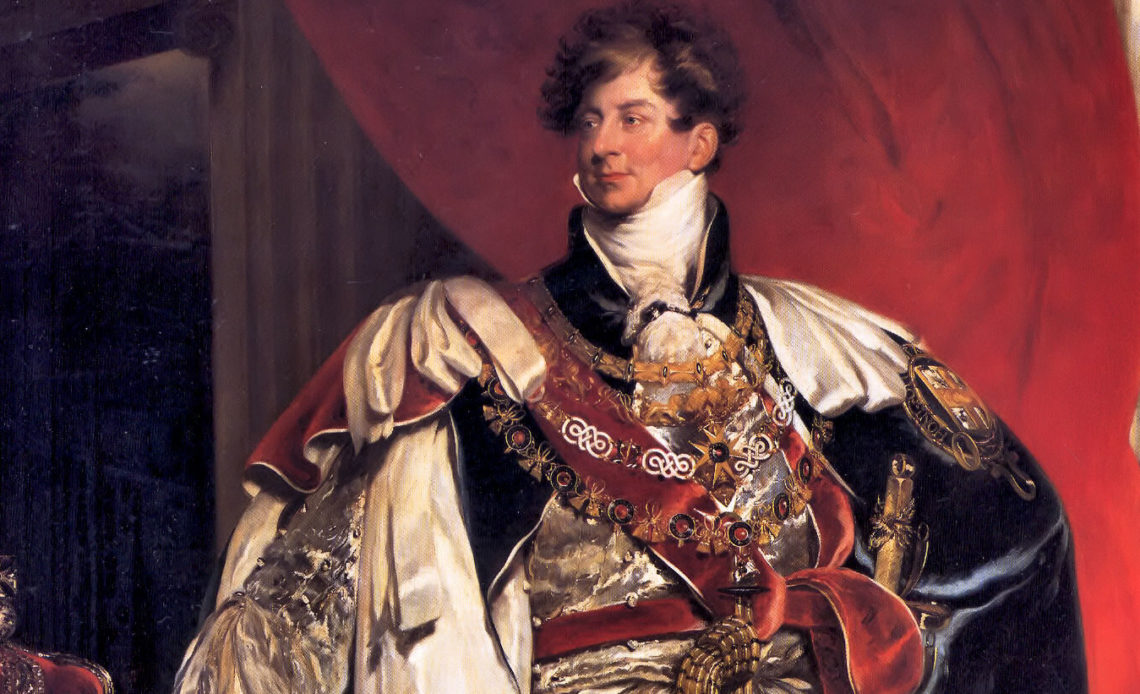
George IV ascended the British throne 200 years ago today. Here, Royal Central’s Assistant Editor, Moniek Bloks, looks at the life of the Regent who finally got to reign.
The future George IV was born at St. James’s Palace on 12 August 1762 to George III and his queen, Charlotte of Mecklenburg-Strelitz. Upon the birth, he automatically became Duke of Cornwall and Duke of Rothesay, but he was also created Prince of Wales and Earl of Chester a week later.
George was soon joined by a brother, Frederick, and the boys shared their upbringing and education at Kew Palace, where George was an excellent student. He was quite popular for his good looks and good manners. Upon his 18th birthday, he received his establishment at Carlton House with an annual allowance of £50,000. Much to his father’s annoyance he began to associate with the Whigs, and he had a penchant for women who were a bit older than himself.
He soon fell in love with Maria Fitzherbert, who was not only twice widowed, but also a Roman Catholic. They married regardless of the religious differences on 15 December 1785 though the marriage was technically void as it happened without the King’s consent (which wasn’t requested, either way!). For political reasons, the marriage was kept secret. Meanwhile, the Prince’s debts continued to accumulate but the King refused to help. So the Prince of Wales began selling off racehorses and letting servants go. This behavior made a good impression on his father, and Prince George received an additional £10,000 per annum and £161,000 to pay off his creditors. But this only caused George to begin a new round of extravagance.
In 1788, George III began to show the first signs of ill health, described at the time as madness but which we know now was porphyria. As the matter of a regency by the Prince would soon become a reality, pressures for him to marry also increased and the promise of increased income led him to consider it. The chosen bride was his first cousin, Caroline of Brunswick. They instantly disliked each other, but the marriage went ahead as planned. They married on 8 April 1795 at the Chapel Royal at St. James’s Palace. It is said George only made it through the wedding and wedding night by being completely drunk. The couple did manage to consummate the marriage and nine months later a daughter, Princess Charlotte Augusta, was born. She would be the couple’s only child as George immediately requested a separation to which Caroline agreed. George returned to Mrs. Fitzherbert, and Charlotte was taken under the King’s guardianship.
George was proclaimed Prince Regent on 5 February 1811 as the King’s illness worsened yet again, and he held that position until his father’s death. But another tragedy would strike George before then. His daughter, Charlotte, had been happily married to Leopold of Saxe-Coburg-Saalfeld (later King of the Belgians) in 1816. Sadly on 6 November 1817 she died after being delivered of a stillborn son in what became known as ‘the triple obstetrical tragedy’. The attending physician committed suicide in 1818 over his guilt and the vast amount of blame placed on him for the loss of the princess. George was so overcome with grief that he could not attend the funeral. Charlotte was buried with her stillborn son at her feet.
On 29 January 1820 King George III died, and his son succeeded him as George IV. His first concern became his wife, Caroline. He wanted to prevent her from returning to England and taking up her position as queen consort (a role that was rightfully hers). He even planned a bill of Pains and Penalties to deprive her of her title, but the bill was dropped after the third reading. His coronation was scheduled for 19 July 1821, but no plans were made for a coronation of Caroline. On the day itself she was refused entry into Westminster Abbey with the row around that overshadowing the coronation itself. She died three weeks later and, at her own requested she was buried in Brunswick where the inscription on her tomb reads, ‘Here lies Caroline, the Injured Queen of England’.
George IV became the first British King to visit Scotland since the Stuarts. Perhaps the most notable event of his reign was the Catholic Emancipation Act though he did his best to block it. In his later years, he lived very quietly, with his last mistress, and divided his time between Brighton and Windsor. He had been a heavy drinker, and this had taken a toll on his health. He suffered from several illnesses, including possibly porphyria. At the end of his life, he spent whole days in bed and by, 1828 he was almost blind. In 1830, his weight was recorded to be 20 stone.
Surprisingly he became very devout in his last months. He made his will in May and died at 3.30 AM on 26 June 1830 at Windsor Castle. He was buried in St. George’s Chapel at Windsor Castle.
As his only legitimate child, Charlotte, had predeceased him he was succeeded as King by a younger brother, William, as the sibling with whom he had shared his nursery days, Frederick, had also predeceased him. The death of Charlotte had left a severe shortage of heirs in the next generation, and this had led to the hasty marriages of his single brothers. William IV was eventually succeeded by the daughter of another younger brother Edward – we know that princess as Queen Victoria.
And Mrs. Fitzherbert, you ask? She was treated kindly by William IV, who even offered to create her a duchess. She did accept the privilege of dressing her servants in the royal livery colours of red and gold. She died on 27 March 1837.
Photo credit: John Singleton Copley [Public domain], via Wikimedia Commons


